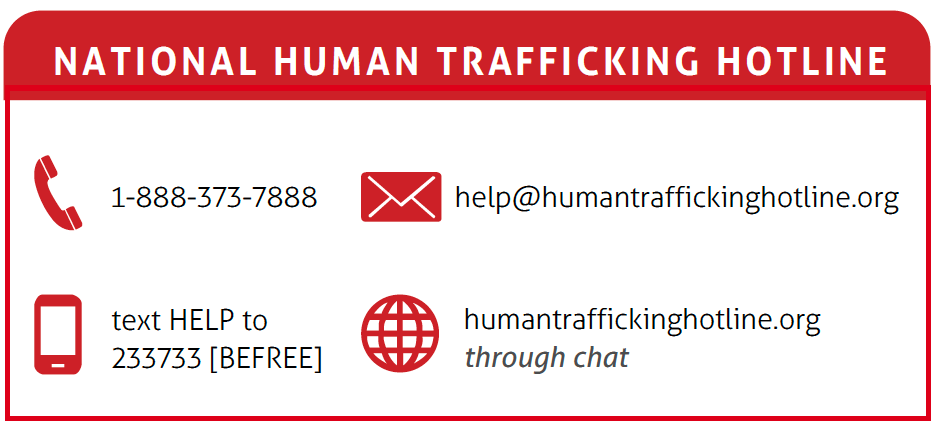Overcoming Our Blind Spots: Pharmacists Can Help Address Human Trafficking
My mind still wanders to her. I remember her broken and hollow smile, tattered jeans, deep frown lines, gaunt frame, and overall appearance and manner that were weary and aged well beyond those of a 28-year-old. She sat under the facility's fluorescent lights, wringing her dry, cracked hands and trying to carefully, almost apologetically, explain that she needed help. She had a self-diagnosed cold but couldn't afford OTC fever reducers. She was homeless with her 3 children. Only a couple of years before she had been a forced domestic laborer—and had been so for 15 years. At the same time, there was a resilience in her, a spirit that sought to survive.
Because the clinic was equipped for these circumstances, we were able to offer her same-day aid and refer her to the county's women's services hotline. Understandably, she was hesitant. We stressed that this was a safe resource, and she agreed to contact them. When we saw her 2 months later, her life had drastically improved, her family had been placed in stable housing, she had access to childcare, and she was rightfully proud to have entered into legitimate employment. Although not completely at ease, she was excited to work with us to address her long-standing health care complaints.

Human trafficking is a global public health issue—with an estimated 27.6 million victims in 2021 working in forced labor.1 Women and girls make up 11.8 million victims, and more than 3.3 million are children.1 Human trafficking estimates in the US are difficult to assess, however. In 2021, 10,359 situations involving 16,554 individuals were reported to the US National Human Trafficking Hotline, but this is believed to represent only a small fraction of the actual people being trafficked.2
The modern equivalent of slavery, human trafficking is the illegal exploitation of people, who are coerced into commercial sex acts and/or forced labor. To address this societal blind spot, we must educate health care professionals about its prevalence and how to identify its victims.
At the time of the experience described above, I was a bright-eyed, 20-something student intern, unexposed to the darker sides of society. Since then, I have encountered similar stories in my work as a naturopathic physician and in my education and training as a pharmacy student at the Creighton University School of Pharmacy and Health Professions in Omaha, Nebraska. The people I encountered as an intern were different ages and from diverse backgrounds, although all had vulnerabilities that left them exposed to traffickers. I learned that although women and children are disproportionately at risk, the victims of trafficking can be United States citizens, foreign nationals, recent migrants, youths without stable homes, those suffering from mental health issues, people struggling with homelessness, those with substance abuse disorder, and people with disabilities.
The traffickers themselves do not always match what is in our mind's eye. In general, most people believe that traffickers are men who were previously unknown to the victims. However, traffickers may be women, and they may have preexisting relationships with the victims, such as relatives, employers, legal guardians, or intimate partners. Most of the time, victims are accompanied everywhere by their traffickers, including to health care visits. In these situations, I noticed that the traffickers tended to dominate the conversation with the medical professional and maintain control over the victim's personal items (identification, cell phone, money, etc.). The victims often had a flat effect; were hesitant to speak; could not clearly answer basic questions about their injuries or medical needs; did not have a fixed address; could not explain how they supported themselves financially; had multiple aliases, multiple phones, unexplained physical injuries, and branding or tattoos that indicate ownership; and/or appeared to be malnourished.
There are also indicators in the pharmacy setting that can point to a human trafficking situation. Patients may be repeatedly filling prescriptions for sexually transmitted infections, emergency contraception, oral contraceptives, OTC pregnancy tests, and pain medications. Patients may have no prescription coverage and pay cash for medications, refills may be requested early, and they may frequently say that prescriptions were lost or stolen.
Even if a person is no longer being trafficked, the repercussions of trafficking are devastating because survivors face barriers to securing basic necessities. These barriers include complex mental and physical health conditions and fear of seeking aid from medical facilities due to conditioning from traffickers. The threads that weave these risk factors and situations together are that these are vulnerable individuals without a social safety net. As health care professionals, we have an obligation to both recognize and act, and we likewise need to be equipped to address the needs of human trafficking victims and survivors.
As medication experts, pharmacy professionals are committed to improving and contributing to the health of individuals through optimizing medication therapy and providing education. Likewise, pharmacists can be critical allies in the fight against human trafficking. The ability to detect human trafficking is extremely important for health care professionals. Research has shown that up to 88% of trafficked individuals are seen by a health care provider during their captivity.3 Training pharmacists to be observant of certain behaviors and how to ask screening questions is critical to identifying red flags.
Experts in human trafficking recommend that screening of vulnerable populations be incorporated into public health and social services. The Adult Human Trafficking Screening Tool is a survivor-centered intervention tool developed by the National Human Trafficking Training and Technical Assistance Center. It includes 8 closed-ended screening questions that professionals can utilize, such as “Sometimes lies are used to trick people into accepting a job that doesn't exist, and they get trapped in a job or situation they never wanted. Have you ever experienced this, or are you in a situation where you think this could happen?” Additionally, it is recommended that the interviewer, with respect to their own safety, create opportunities to be alone with suspected victims, away from the trafficker.3
At Creighton University clinics, we utilize the Health, Education, Advocacy, Linkage (HEAL) trafficking protocol tool kit, which has been adapted to suit our facilities' and patients' needs. HEAL is a comprehensive, evidence-based tool to equip medical professionals to address human trafficking.5 The tool kit helps the user build a network of multidisciplinary professionals to use as resources and implement strategies for communicating with victims.
My experiences with human trafficking survivors were impactful. They made me aware of this global health problem and led to my commitment to be ready to recognize and act when I encounter it in my future practice as a pharmacist. If you suspect human trafficking, try to safely create an opportunity to speak with these patients and get to know their story.

About the Author
Shamiron Shahbaz-Arami lives in Portland, Oregon. She is a third-year pharmacy student at Creighton University School of Pharmacy and a licensed naturopathic physician who works in an ambulatory care clinic. She has worked in community health treating at-risk populations. Her pharmacy areas of interest include public health initiatives, oncology, and pediatrics. She enjoys painting and hiking in her spare time.
References
1. Global Estimates of Modern Slavery: Forced Labour and Forced Marriage. International Labour Organization, Walk Free, and International Organization for Migration; 2022. Accessed February 16, 2023.
2. Polaris. Polaris analysis of 2021 data from the National Human Trafficking Hotline. Accessed February 16, 2023.
3. US Department of State. 2004 Trafficking in Persons Report. Presented at: Interdisciplinary Conference on Human Trafficking at the University of Nebraska; October 29-31, 2009; Lincoln, NE. Accessed February 16, 2023.
4. Administration for Children & Families Office on Trafficking in Persons. Adult Human Trafficking Screening Tool and Guide. January 2018. Accessed February 16, 2023.
5. Baldwin SB, Barrows J, Stoklosa H. Protocol toolkit for developing a response to victims of human trafficking. Health, Education, Advocacy, Linkage (HEAL). June 2017. Accessed February 16, 2023.
This “Eyes on Trafficking” story is reprinted from its original online location.
Fair Use Notice: The PBJ Learning Knowledge Vault is dedicated to advancing understanding of various social justice issues, including human trafficking and related topics. Some of the material presented on this website may contain copyrighted material, the use of which has not always been specifically authorized by the copyright owner. We are making such material available in our efforts to promote education and awareness of these important issues. There is no other central database we are aware of, so we put this together for both historical and research purposes. Articles are categorized and tagged for ease of use. We believe that this constitutes a ‘fair use' of any such copyrighted material as provided for in section 107 of the US Copyright Law. In accordance with Title 17 U.S.C. Section 107, the material on this site is distributed without profit to those who have expressed a prior interest in receiving the included information for research and educational purposes. For more information on fair use, please visit: “17 U.S. Code § 107 – Limitations on exclusive rights” on Cornell Law School's Legal Information Institute.

ABOUT PBJ LEARNING
PBJ Learning is a leading provider of online human trafficking training, focusing on awareness and prevention education. Their interactive Human Trafficking Essentials online course is used worldwide to educate professionals and individuals how to recognize human trafficking and how to respond to potential victims. Learn on any web browser (even your mobile phone) at any time.
More stories like this can be found in your PBJ Learning Knowledge Vault.
EYES ON TRAFFICKING
This “Eyes on Trafficking” story is reprinted from its original online location.
ABOUT PBJ LEARNING
PBJ Learning is a leading provider of online human trafficking training, focusing on awareness and prevention education. Their interactive Human Trafficking Essentials online course is used worldwide to educate professionals and individuals how to recognize human trafficking and how to respond to potential victims. Learn on any web browser (even your mobile phone) at any time.
More stories like this can be found in your PBJ Learning Knowledge Vault.

